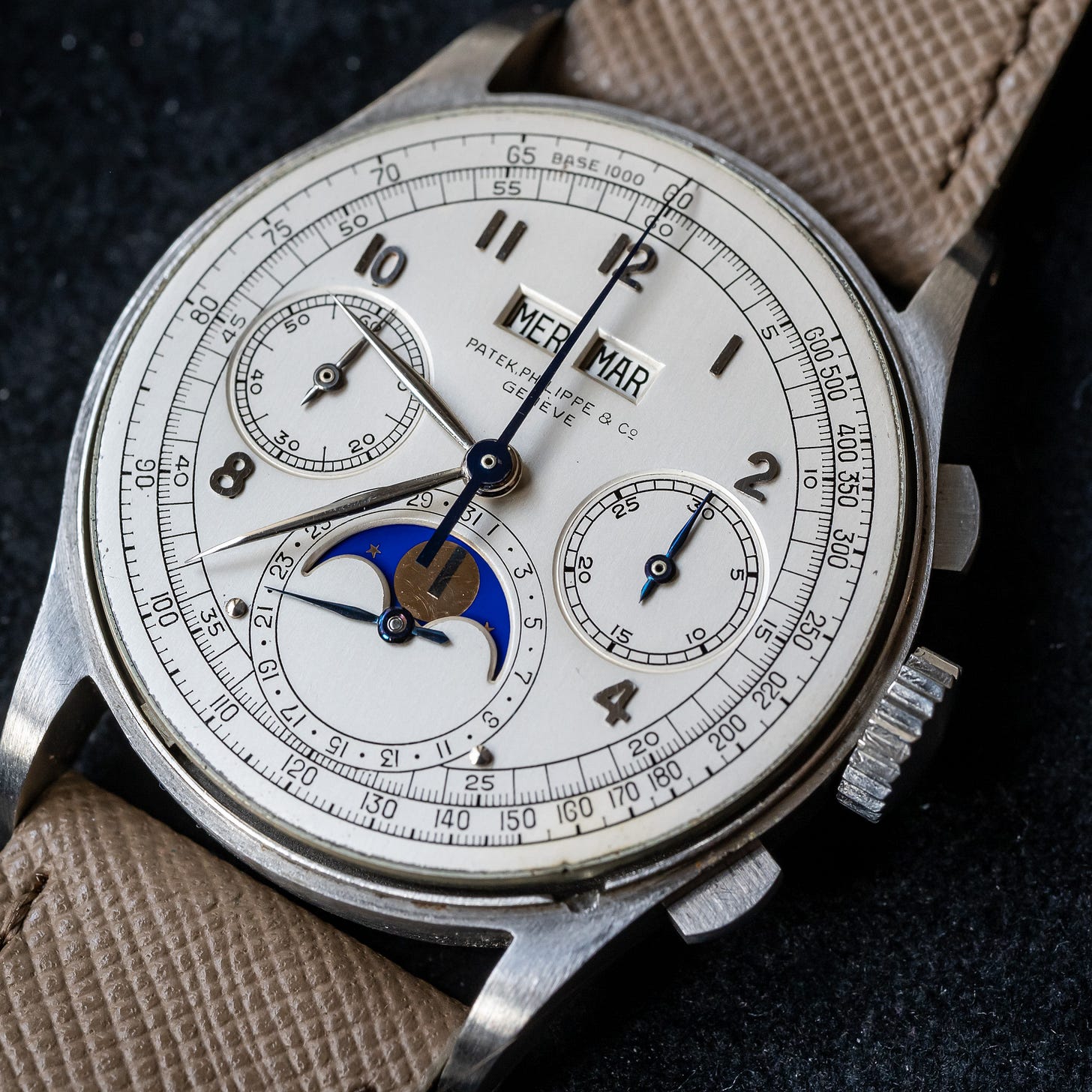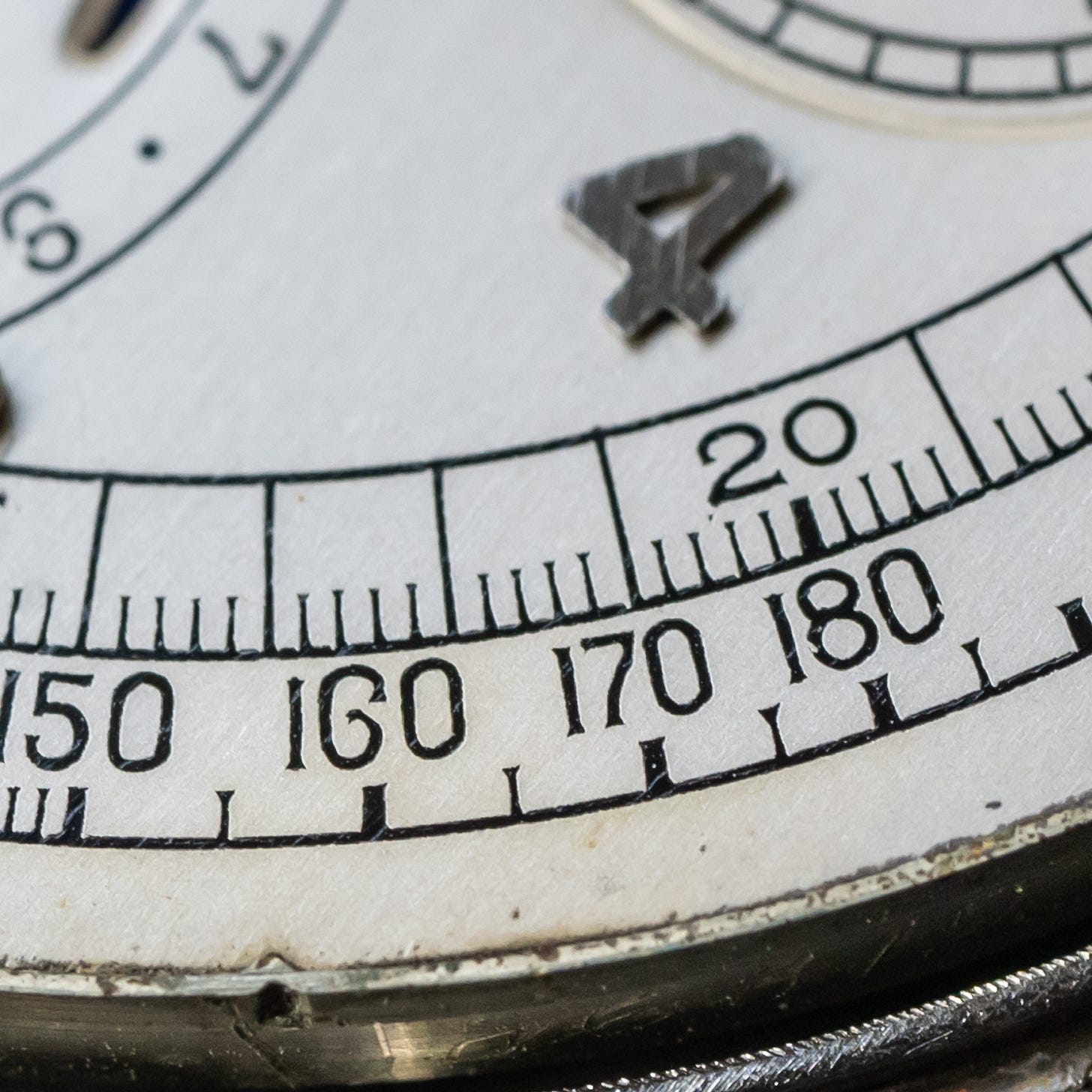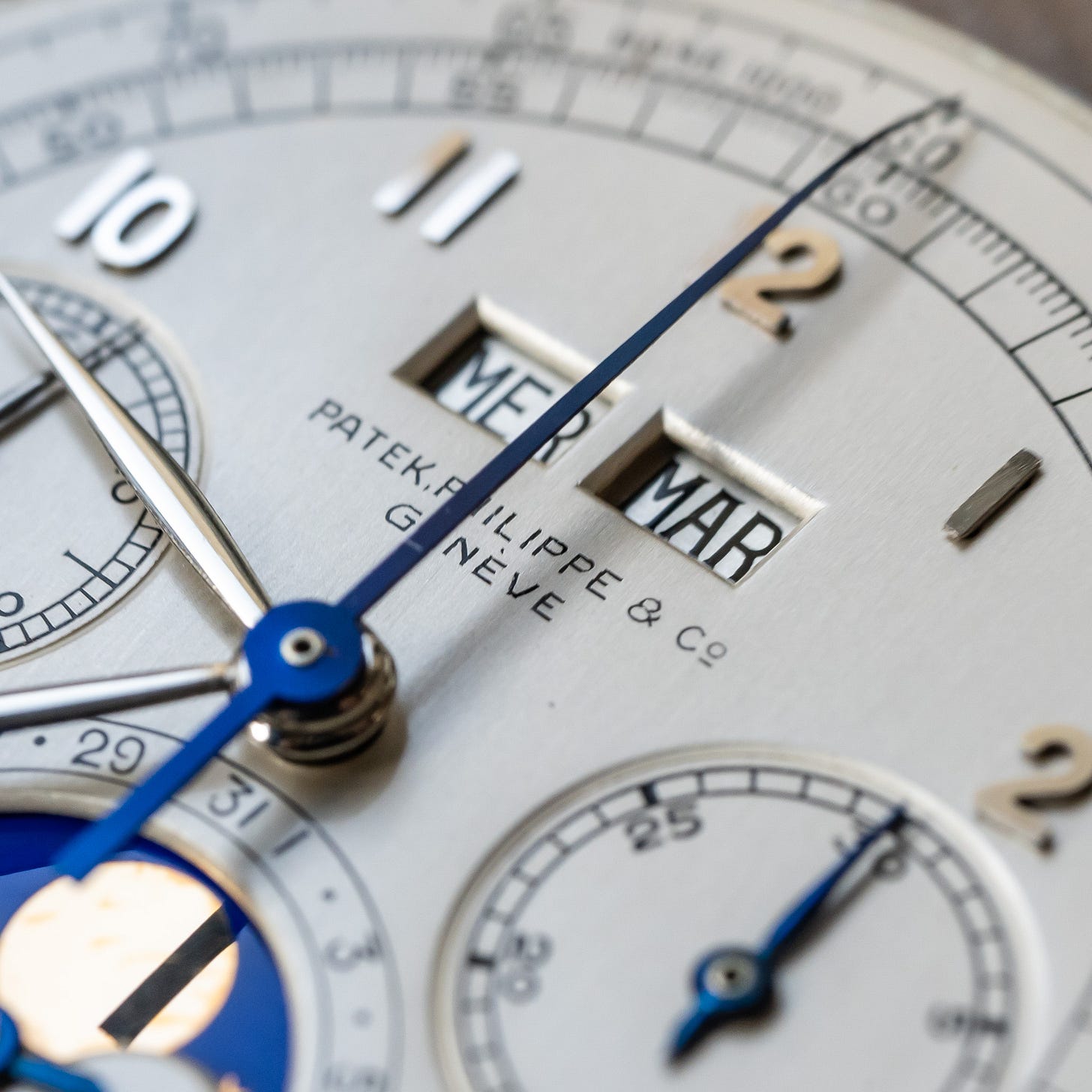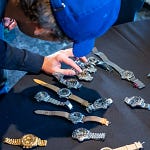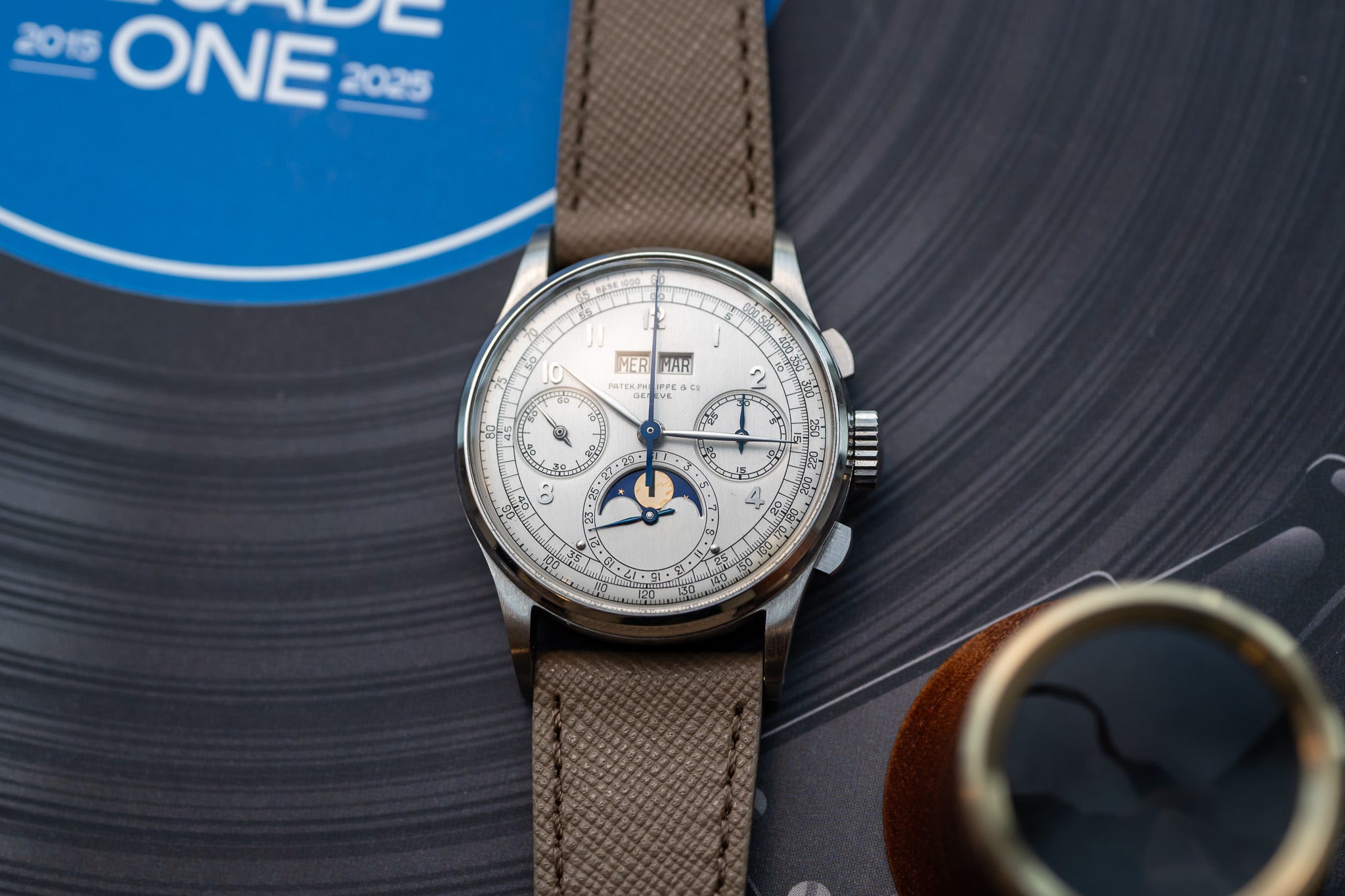
I. Pink Gold 2499
There was a pink-gold Patek Philippe 2499 behind me, at about my 7 o’clock. On the Friday morning of the Geneva auction weekend, I was drinking a 12-franc cappuccino in the Mandarin Oriental’s restaurant with a friend. Pink Gold 2499 was at the table behind us, enjoying the CHF 42 continental breakfast with his family after landing in Geneva an hour earlier.
This wasn’t just any 2499, but a First Series, perhaps the one that sold for CHF 3.1m just last year, and the only known with the larger Wenger case. It turned out my friend knows Pink Gold 2499, so we were introduced as I left the Mandarin and my half-drunk cappuccino, pretending not to care about the wasted 6 francs. Pink Gold 2499 was friendly and casual, especially for a Pink Gold 2499. We exchanged WhatsApp and Instagram handles.
The next afternoon at Phillips’ 10th anniversary sale, Pink Gold 2499 was again at roughly 7 o’clock behind me. We both sat there for 90 minutes, this time surrounded by 500 people, half standing around the perimeter of the ballroom of the Hotel President Wilson, all waiting for Lot 23: Patek Philippe Ref. 1518, “A genre-defining, historically important, highly collectable stainless steel perpetual calendar chronograph wristwatch with moonphase display, one of four known. (Estimate: In excess of CHF 8m).”
As Lot 23 came up and Aurel Bacs began his pitch for the Steel 1518, Pink Gold 2499 interrupted to shout:
“8 MILLION!”
“A bid from a savvy Chinese collector,” Bacs said from the rostrum. The interruption was the perfect hook for a short-form video, though perhaps not the way an auction house would’ve preferred to slowly build momentum for the biggest watch of the weekend and one of the most important in the world.
After that, bidding was as slow as the air is thin above 8 million francs, though at least five bidders got involved after Pink Gold 2499’s bid. A playful moment came at CHF 10m when dealer Davide Parmegiani placed a bid.
“You don’t have a premium paddle, but you have a premium name,” Bacs said as he took the bid from his friendly rival and the chairman of Monaco Legend.
Bacs was auctioning off the first steel 1518, while Parmegiani had just completed a private sale of the third steel 1518 (rumor is the buyer’s a low-key European collector). The second example is documented in collector Sandro Fratini’s My Time (and has the most raw dial), while the fourth and final known is slightly different from the first three because it features a larger case made by Wenger. The first three have cases by Genevor.
After nearly 10 long minutes of bidding but mostly waiting, this Steel 1518 hammered for CHF 12m, an all-in price of CHF 14.19m ($17.6m, just shy of Paul Newman’s Paul Newman in 2017), going to a winning bidder on the phone.
II. Timex

At auction previews, you’re typically helped by a viewing assistant. A young 20-something with dreams of working in “luxury” hands you a pencil and paper where you write down a few lots at a time, which they then dutifully bring over on a tray. I chatted with my assistant at Christie’s, a recent university graduate from a hospitality program in nearby Lausanne, Switzerland.
He was 23 and wearing a Timex as he carried over a pink-gold Rolex “Jean Claude Killy” (sold: CHF 520,700) and a black dial Patek 570 (sold: CHF 419,100) on a black velvet tray. The assistants don’t know or care if you’re a superdealer or a lookie-loo like me—mine even offered to hold my light as I took a few photos of my favorite watches.
But back at the Phillips preview, the Steel 1518 was different. It had to be signed out and supervised by one of Phillips’ higher-ranking specialists. I’m told it’s in the same condition as when Phillips last sold it in 2016. It may not have even left Geneva. While the other auctions squeeze their previews into hotel ballrooms with no natural light, Phillips builds a temporary structure on top of the pool deck at the five-star President Wilson. There’s a view of Lake Geneva. The way these beautiful watches are fondled all weekend by barbarians and newsletter writers feels almost undignified for such pieces of history, but at least the 1518 gets a view of the lake.
Once Lot 23 arrived, time stamps on my camera suggest I got about 4 minutes with the Steel 1518, but it felt like no time at all.
Phillips knew I wanted more time, especially given the online discussion from Perez and others, about the dial condition of the 1518. So they asked if I wanted to come back for the opportunity to see and photograph the dial with the crystal off.
Of course, I said yes. Here’s what I saw.
III. Engraved Enamel
Recently, I dedicated an article to engraved enamel dials. Given its relevance to these auctions, I’ve unlocked it for everyone. It’s the most useful introduction to the engraved enamel process I’ve found online. As I explain:
“These dials were designed to be cleaned and restored to last for generations, unlike the ink of pad printing, which fades with time. This engraved enamel process involves more steps and craftsmanship than printing, which is why it was only used by high-end brands.”
Old Patek Philippe watches feature engraved enamel dials, and most show some signs of cleaning or restoration. “Restoration” isn’t an inherently bad word. Some restorations are sympathetic and less invasive; others, less so. Where you draw the line is often a matter of taste. One collector sees blemishes; another sees raw originality. Most of us live somewhere in between.
Original engraved enamel is clean and crisp, with sharp, uninform markings. When these dials are “washed” or “cleaned,” this typically means some solution or chemical was used to clean the dial. This can cause the dial to lose some of its hard enamel, and markings may start to look uneven or faded. Sometimes, this is painted over with “soft” enamel after a cleaning. While hard enamel is typically slightly raised, soft enamel looks more like paint. Dials may also be sanded during cleaning, which can soften calendar cutouts and subdials. It’s often said this can create subtle vertical striations, though it must also be mentioned that vertical brushing could also be applied during original production.
With its crystal off, the Steel 1518 reveals the quiet scars of its 80 years—some cleaning, some fading, some mystery:


Cleaning. Phillips’ condition report says it "may have possibly seen one light professional surface clean.” Lot descriptions and condition reports can be useful, but they’re also sales pitches. Especially given the enamel loss in certain spots, I’m comfortable saying it’s been cleaned.
Patek Philippe & Co. logo. The 12 o’clock logo is more faint than the rest of the dial markings. It shares this with the third steel 1518, recently sold by Parmegiani. It could mean they left the factory this way, or that they have handled 80 years of wear similarly.
Indentation. Interestingly, the logo appears slightly indented. It’s perhaps most helpful to analyze watches by comparison, so let me start here: I’ve had the opportunity to loupe one other steel 1518 besides this one (not Parmegiani’s). Its 12 o’clock logo has the exact same indentation. Again, I don’t know if the dials were born this way, or if this is the result of 80 years of aging. But at least two of the steel 1518s share this characteristic.

Outer scales. The outer scales look raised, which is what you’d expect of an engraved enamel dial. There is some visible enamel loss. Some numerals have partial enamel missing, while some scales show signs of wear. For example, note 6 o’clock where the date subdial and all scales converge (below).
Vertical striations. As mentioned, it’s often said a vertical pattern can indicate cleaning with a slight abrasive. In places, you can see vertical striations or scratches that seem to stretch across the silver of the dial and the enamel:


Here’s what else we know: This dial has looked the same since at least 2010, when it was published in John Goldberger’s Stainless Steel Patek Philippe (image here). Since then, it’s passed from Alfredo Paramico to a well-known Australian collector, and twice through Phillips. Anyway, cleaning and restoration are to be expected for an 80-plus year old Patek that also happens to be one of the most famous watches in the world.
Scroll through the photos in my engraved enamel article and you’ll see watches with crisper signatures and scales. They also tend to be younger. And of course, there’s no stainless steel 1518. If you want one of those, you can’t exactly be picky. And you’ve gotta be ready to pay up. Meanwhile, I can hardly leave behind six francs of cappuccino at the Mandarin.
In Phillips’ great video about the steel 1518, Parmegiani explains that washing a dial affects its condition, but not its originality. A dial can be washed but still perfectly original. He goes on to say that of the roughly 80 ref. 1518s he’s sold in his career, perhaps five had untouched dials.
Dealer John Reardon makes a broader point: Watches are literally living objects. In vintage Patek Philippe, the movement oil and the Zapon—the clear protective layer on top of the dial—are organic compounds. They naturally degrade over time, eventually necessitating preservation and restoration.
Perhaps the best illustration of original hard enamel compared to a restored dial I saw this week came on two Agassiz world timers. One was owned by a private collector; the other sold at auction:

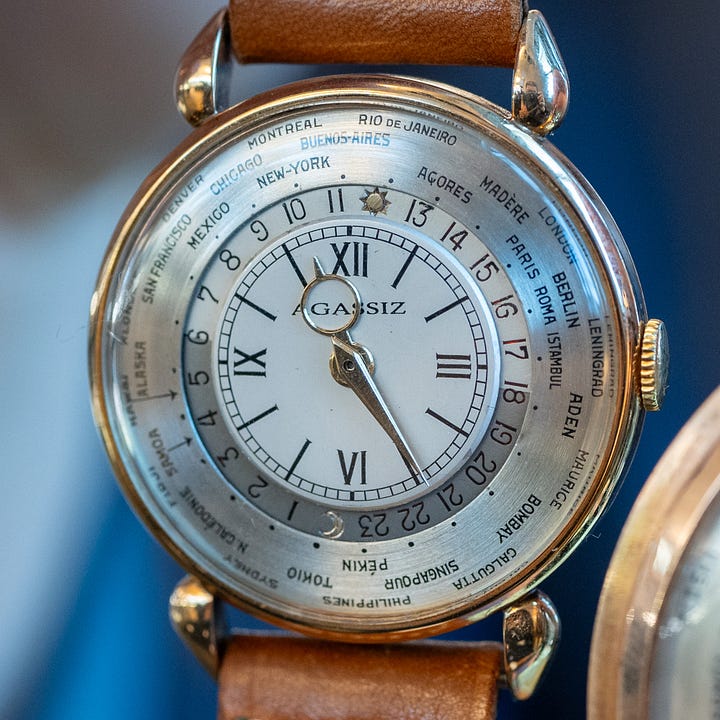
IV. It’s Okay to Say ‘I Don’t Know’
In that Phillips video, Parmegiani says: “Restoration is something the market has to understand, otherwise they will not be able to understand, love, and appreciate the pieces they see.”
This time around, the discussion about the Steel 1518 got completely wrapped up in condition, enamel, and logo indentations. As I left the room after photographing the 1518, I had to remind myself: This newsletter might never cover a steel 1518 again.
But this is also where the watch industry can do more. Rediscovering the history of an 80-year-old watch is like putting together a jigsaw puzzle that’s missing half its pieces. It’s impossible to know for sure what’s been done to it. Especially if dealers or experts hold whatever pieces they have close to the chest. In fact, this is the very joke I was trying to make with the name of this newsletter: Sellers call watches “unpolished,” when in fact, it’s nearly impossible to prove whether a case has been polished or not.
I spent 45 minutes with the Steel 1518, crystal off, and I’m comfortable to say: I don’t fully understand the puzzle.
I like to think there’s a certain confidence in being able to say I don’t know. Admitting that I don’t have all the answers, especially when it comes to 1518s. Be skeptical of anyone who speaks in absolutes.
Condition and restoration are still not discussed in the open enough. This causes them to be thrown around like bad words, which leads people to make illogical leaps from “washed” to “franken” to “fake,” when in fact cleaning a dial doesn’t affect originality or authenticity.
When the industry doesn’t educate, people fill the gaps with assumptions, conspiracies, and worst-case scenarios. It’s on us to offer knowledge and clarity before confusion takes hold.
That video discussion between Dr. Helmut Crott, Reardon, Bacs, and Parmegiani was a great start, an introduction to how dealers at that level discuss restoration and condition. It would’ve been compelling to see them take it one step further— to discuss how that thinking applies to this particular 1518.
Phillips letting me take and publish these photos is another great step (thank you!). Of course, their main obligations is to their clients.
And there, it’s the result that matters: CHF 14,190,000.
Leave a comment or heart if you enjoyed this dispatch. I posted a quick video of much of the bidding on the Steel 1518 without commentary. The comments, for some reason, got nasty. But I trust the thoughtful Unpolished newsletter audience will be more civil!
Lot Notes
Across the auctions, one theme I saw play out was major players paying respect to the history of watches by bidding at auction. Here’s who won that Mercedes Gleitze Rolex, and what FP Journe walked away with:
Listen to this episode with a 7-day free trial
Subscribe to Unpolished Watches to listen to this post and get 7 days of free access to the full post archives.





